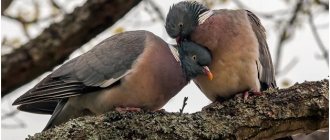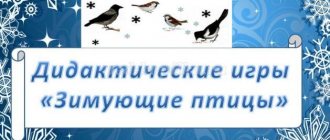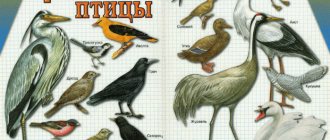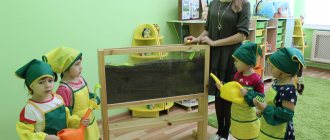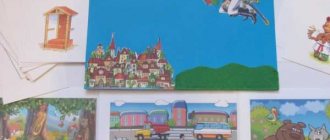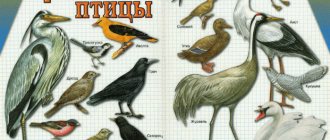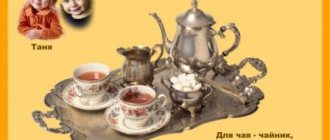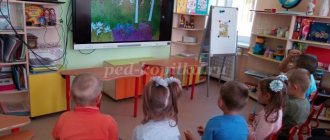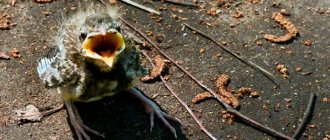Progress of the lesson
1. Organizational moment. Game exercise with a ball “Name the signs of winter.”
- Guys, when I came to work, there was an envelope on my desk with a letter in which it was written that something was happening in the Winter Forest. Some birds , there are no swallows, no starlings. Has trouble really come to the forest?
-Let's try to figure out what happened.
All snow and snowdrifts
The whole forest and the whole field are covered in snow.
A forest road appears through the snow,
Here are the fox tracks in the snow.
-What is this poem about? Look out the window and tell me what time of year it is? (winter)
-What do you imagine when you hear the word WINTER? (snow, ice, forest, slide, sled, cold, blizzard)
Reading the poem again.
What sound occurs most often in this poem? (sound)
Say it slowly: S-s-s-s-s
-Come up with words related to winter, where the sound “C”
(snow, snowdrift, snowflake, snowman, Snow Maiden, laughter, fairy tale, sled, sled, snow scooter, icicle, snowball.)
-What kind of winter is it (cold, frosty, snowy, windy, blizzard)
- Now you will take turns naming the signs of winter.
*if the blizzard is blizzard
2. Introduction to the topic. [ Development of speech hearing , thinking, coherent speech . ]
-Oh, guys, look, there are so many inhabitants in the forest, let's take a look.
carefully and tell us who is visiting our forest?
• Look and tell me who you see here? ( Birds )
.
• How did you determine this? (Beak, feathers)
.
• List these birds . (Bullfinch, magpie, crow, tit, sparrow.)
.
• How did you guess that it was a bullfinch? (Red breast)
.
• How did you determine that it was a magpie? (Long tail, white sides)
.
• How did you determine that it was a crow? (Black, large)
.
• How did you determine that it was a tit? (Yellow breast)
.
• What kind of birds ? ( wintering )
.
• Why do we call them that?
Well done, now let's solve the riddles
1) I’m knocking on wood, I want to get a worm, Even though it’s hidden under the bark, you’ll still be mine. (woodpecker)
2) Red-breasted, black-winged loves to peck grains.
With the first snow on the mountain ash, He will appear again.
3) She is a little bird, and her name is.
4) This bird is the same color as the birch tree. Who is it?
5) He wears a gray vest, but the wings are black. You see - twenty pairs are circling and shouting: kar-kar
With children, look at the pictures of wintering birds (crow, sparrow, tit, owl, pigeon, magpie, bullfinch, crossbill, etc.)
;
remember their characteristic external features (tail, beak, color, size)
; where they live, what they eat.
4. Game with the ball “One-many”. (Improving the grammatical structure of speech invites children to the carpet).
- Let's play a game with the ball "One-many." I will throw a “sounding” ball to each of you and name one bird . You will catch the ball, name a lot of birds and return the ball to me.
5. Physical school
.
Improvisation of movements. In winter we play in the snow, we play, we play. We walk through the snowdrifts, we walk, we walk. And on skis we run, we run, we run. We fly on ice skates, we fly, we fly. And we sculpt the Snow Maiden, we sculpt, we sculpt. We love the winter guest , we love, we love.
6. Didactic game “Name it kindly”
-Where birds fly to dine in winter (to the feeder)
7. Let's play the game "Snowman"
.
I will say the beginning of the sentence, while throwing you a ball, and you will add the word snowman, but at the same time correctly change the ending, returning the ball to me (picture of a snowman)
We decided to build (a snowman)
.
We attached a carrot nose to our (snowman)
.
We showed our (snowman)
.
We played with our (snowman)
.
We told grandma about (snowman)
.
We had fun sculpting... (snowman)
.
Now we have figured out what happened in the winter forest, where some birds .
-Well done, did you like our lesson ?
— What did you like more?
-What birds were we talking about? (about wintering )
-What wintering birds do you remember ?
(After the lesson, you can show the children another photo, a cartoon about wintering birds to reinforce the lesson )
Attached files:
Summary of an integrated lesson on speech development in the senior group “Wintering and migratory birds” Synopsis of an integrated lesson on speech development in the senior group on the topic: “Wintering and migratory birds”.
Goal: clarify and expand. Summary of direct educational activities on speech development in the middle group “Birds wintering with us” Summary of educational activities on speech development in the middle group. Topic: “Birds wintering with us” Objectives: 1. To consolidate children’s ideas about wintering birds.
Summary of educational activities for speech development in the preparatory speech therapy group “Wintering Birds” Topic: “Wintering Birds” Goals: to form an ecological culture in children; instill a love for birds and cultivate a caring attitude towards them.
Preview:
Speech development in children 4-7 years old.
1. While walking with your child in the forest or park, watch the birds, show them wintering birds: bullfinch, tit. In this case, you should draw the child’s attention to the colors of the birds. Specify the structure of the bird's body (back, chest, head, wings, tail, legs).
2. Tell where they live and what they eat.
3. Draw your child’s attention to which birds often fly into the yard (pigeon, crow, jackdaw, sparrow, tit). It is advisable to feed the birds with your child.
4. Look at the illustrations of wintering birds (it is advisable to use the book by N. E. Teremkova “Speech therapy homework for children 5-7 years old with OHP”, album 2, p. 26).
6. Exercise “Call it kindly” to form a noun using diminutive suffixes.
7. Exercise “Count the birds” for agreeing a numeral with a noun.
12. Retelling based on questions. Development of coherent speech. Listen to the story and answer the questions in complete sentences.
It was winter. It was severely frosty. Children in the park found a frozen sparrow in the snow. He lay there and didn't move. The children warmed the sparrow in their hands, and then put it in a warm mitten and carried it home. At home, the sparrow warmed up and began to fly around the room. The children fed the sparrow with bread crumbs and seeds. When the severe frosts ended, the children released the sparrow into the wild and hung a feeder with food in the park to help the birds survive the cold winter.
Questions: What time of year was it? Who did the children find in the snow in the park? What kind of sparrow was it? What did the children do to prevent the frozen sparrow from dying? When did the children release the sparrow into the wild? What did the children hang in the park in winter? For what?
14. Development of fine motor skills.
(Rhythmically clench and unclench your fists) How many birds have flown to our feeder? (For each name of bird, bend one finger) Two tits, a sparrow, Six goldfinches and pigeons, A woodpecker with motley feathers. (clench and unclench your fists again) There were enough grains for everyone!
1. I recommend asking your child what wintering birds he knows; why they don’t fly away (we teach how to establish cause-and-effect relationships). Remember their names, characteristic features (tail, beak, plumage, size), where they live, what they eat, why they are called winterers.
3. Have a conversation about caring for birds and the need to feed them in winter.
4. Make a feeder together with your child and hang it outside. While walking, observe which birds fly to the feeder.
5. Exercises on the grammatical structure of speech. Repetition (the material must be mastered before the age of 5), see the description of the exercises above (homework for children 4-5 years old): “Call it affectionately”, “Say when there is a lot”, “Count”, “Who gives what voice” , “Say it in one word.”
6. Exercise “Whose, whose, whose, whose?” for the formation of possessive adjectives. The girl Tanya hung the feeder on a tree. When the birds flew away from the feeder, the girl Tanya found different feathers on the feeder. Help Tanya figure out whose feathers were on the feeder. Complete the sentences. Crow feathers (whose?). sparrow feathers (whose?). bullfinch feathers (whose?). pigeon feathers (whose?).
7. Exercise “Choose a sign” to coordinate nouns with adjectives. The tit (what?) is yellow-breasted, nimble, small, agile. Sparrow (which one?). Bullfinch (which one?). crossbill (which one?).
8. Learn to select words with the same root. Feed, feed, feeder, fed, feeding (birds).
9. Coherent speech. Retelling without relying on questions.
Feeder. Children saw birds near the school in winter. They threw crumbs of bread at them. The birds were afraid at first, and then they ate all the bread. The next day the birds arrived again. The children took the box, hung it on a branch and poured grains. The feeder came out. The children fed the birds until spring.
For retelling, you can (preferably) use the book “Retellings all year round” by author T. Yu. Bardysheva from the series “Speech Development. 4 baby books." The book was published by the publishing house "Karapuz", it can be purchased by subscription (subscription index 34227), on the website of the publishing house "Karapuz". In Moscow, the book can be bought at the Biblio-Globus store (Myasnitskaya St., 6).
10. Development of fine motor skills. Draw a picture for the story “Feeding Trough”. The drawing can be used when retelling.
11. Learn a poem by heart (any poem of your choice).
The sparrow is barely alive, not even tweeting. The sparrow freezes completely. As soon as he notices a cart with luggage, he rushes from under the roof towards it, And he trembles over the grain, poor thing, And flies to his attic. And look, he doesn’t become harmful because it’s so difficult for him... (N. Rubtsov)
Crow Here is a crow sitting on the fence. All the barns have been locked for a long time. All the carts have passed, all the carts have passed, the time has come for bad weather. She's fussing about on the fence. Woe to her. Real grief! It's not a grain that the crow doesn't have. And there is no defense against the cold. (N. Rubtsov)
Tit The nimble tit is jumping, She can’t sit still. Jump-jump, jump-jump, Spun like a top. So she sat down for a minute, scratched her chest with her beak, and from the path to the fence, Tiri-tiri, shadow-shadow-shadow. (A. Barto)
